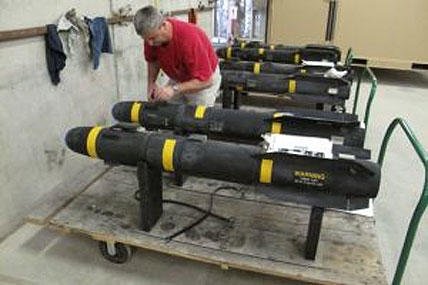The U.S. will speed up deliveries of Hellfire missiles and small ScanEagle reconnaissance drones to Iraqi forces battling resurgent Sunni militants in western Anbar province, but the new arms shipments will not arrive for several months, Pentagon officials said Monday.
The officials sought to minimize the threat posed to the Shiite-dominated government of Prime Minister Nouri al-Maliki by the takeover of Ramadi and Fallujah by insurgents from the Al Qaeda-linked Islamic State of Iraq and the Levant (ISIL), which seeks to establish a Sunni caliphate in Anbar and parts of Syria.
Ramadi has mostly been taken back by police and local tribal militias, with ISIL fighters reduced to pockets of resistance. Meanwhile, the Iraqi army was preparing a push on Fallujah, said Army Col. Steve Warren, a Pentagon spokesman.
In addition, "we're working closely with the Iraqis to develop a holistic strategy" for defeating ISIL and restoring trust between the Baghdad government and the restive Sunni population in Anbar, Warren said.
About 100-200 U.S. troops for the Office of Security Cooperation-Iraq (OSC-I) were on the ground in Iraq to handle the arms shipments and advise the Iraqis on their use, but Pentagon officials echoed the recent statement by Secretary of State John Kerry that no U.S. forces will take up combat roles.
"We're not contemplating putting boots on the ground," Kerry said in Jerusalem during a visit to the Middle East last week. "This is their fight, but we're going to help them in their fight."
During the U.S. war in Iraq, more than one-third of the U.S. casualties occurred in Anbar province.
On Monday, Prime Minister Maliki urged the Iraqi army not to hit residential neighborhoods in the push to take back Fallujah. At the same time, Maliki also urged Fallujah residents to help the army in expelling the insurgents.
The 100 AGM-114 Hellfire missiles and 10 ScanEagle unmanned aerial vehicles had been scheduled for delivery to Iraq in the fall but "we've escalated the planned delivery." The shipments will be completed this spring, Warren said.
Last month, the U.S. sent 75 Hellfire missiles to Iraq and several have been used in the fighting in Ramadi and Fallujah.
Despite the impasse with Iraq in 2011 that prevented the U.S. from leaving a residual training and advisory force in the country, the U.S. has continued to ship billions in weaponry to Iraq through OSC-I and the Foreign Military Sales program overseen by the State Department.
Since 2005, total U.S. arms sales to Iraq have passed $14 billion, including six C-130 aircraft, 27 helicopters and 12 patrol boats, Pentagon officials said.
Last July, the Defense Department notified Congress of the intent to sell Iraq about $2 billion in arms, including Stryker infantry carriers and hundreds of millions of dollars worth of spare parts for thousands of Iraq's American-made military vehicles.
In August, another $2.4 billion deal with Iraq was announced for the additional sale of arms including 681 Stinger anti-aircraft missiles, Sentinel radars, and three Hawk anti-aircraft batteries.
In his visit to the White House in November, Maliki pleaded for more arms and assistance from the U.S. and also joined with President Obama in a statement urging the revival of the "Sons of Iraq" in Anbar province to combat insurgents.
The joint statement called for "security operations coordinated with local officials, and renewed efforts to empower local security structures, such as the Sons of Iraq, to mitigate extremist infiltration."
The "Sons of Iraq," local militias recruited by tribal sheikhs and paid by the U.S., were considered a major factor in the success of the U.S. troop "surge" in 2007 in beating back Al Qaeda insurgents in Anbar province and other Sunni majority areas.































